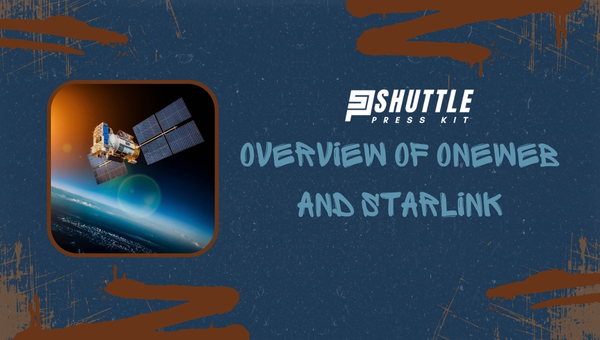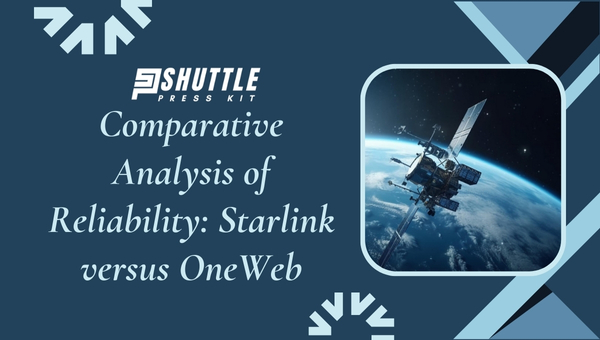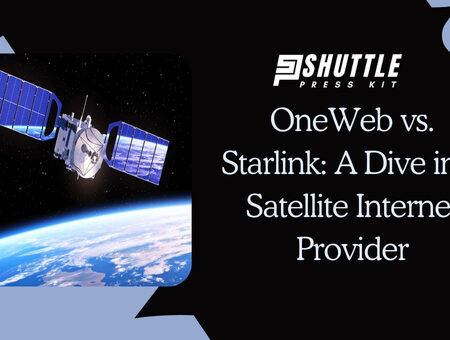Struggling to choose between OneWeb and Starlink as your satellite internet provider? Well, you’ve come to the right place. This comprehensive guide will compare these two key players in the satellite internet industry, giving you a leg up when deciding which service best suits your needs.
When it comes to comparing OneWeb vs. Starlink, there isn’t a clear-cut answer due to varying factors such as technological advancements, speeds offered, coverage area, and pricing. However, by taking an in-depth look at each company’s offerings and obstacles they face on their global operational front, we can help you decide which among these satellite internet providers aligns best with your requirements.
Overview of OneWeb and Starlink
In today’s fast-paced world, having a reliable internet connection is more important than ever. Two major companies, OneWeb and Starlink, are stepping up to meet this need by creating networks of satellites in space.
Their goal is simple: provide high-speed internet access to every corner of the globe, especially in places where it’s hard to get. Both companies are launching hundreds of satellites into orbit, but they have different plans and technologies to connect people everywhere.

What is Starlink?
Starlink is a project by SpaceX, a company run by Elon Musk. It aims to surround the Earth with thousands of small satellites. These satellites work together, forming a huge network or “constellation” that can send internet signals directly to small dishes at homes or businesses.
The idea is like passing a ball from one person to another until it reaches its target. This means if you have Starlink equipment, you can get fast internet even if you’re in the middle of nowhere.
What makes Starlink special? It’s designed to be super fast and cover large areas without needing lots of ground infrastructure like cables or towers. So far, many people in remote places have started using Starlink and say it’s much better than their old connections.
Also, because SpaceX has lots of rockets and launches often, they can send more satellites up quickly which should make the service even better over time.
Also Read:Free Internet for Low-Income Families: Unlock Possibilities
What is OneWeb?
OneWeb, on the other hand, has a similar yet distinct approach compared to Starlink. Founded with the vision that everyone everywhere should have access to the internet, OneWeb also builds a constellation of satellites orbiting Earth but focuses on working with businesses rather than selling directly to individual consumers at first. Like pieces in a giant jigsaw puzzle floating above us, these satellites aim to provide coverage across the globe by bouncing signals from space down to simple antennas on the ground.
Unique about OneWeb is its emphasis on connecting difficult-to-reach areas such as schools in rural regions or ships at sea —places traditionally left off the digital map due to high infrastructure costs on land-based methods (like laying cables).
By partnering with businesses that already serve these communities or industries; OneWeb plans not just for widespread coverage but also hopes it can help improve education and economies by making information more accessible for all corners of our planet over time.
Performance
When we talk about internet from space, performance is a big deal. Performance means how fast and reliable your internet is. Just like when you’re watching videos or sending emails, you want everything to work fast and without stopping. This is where OneWeb and Starlink come in, each trying to provide the best service they can.
OneWeb
OneWeb wants to make sure people everywhere can use the internet quickly and without waiting. To do this, they send more than 630 satellites up into space. These satellites are not very far from Earth. This means they can send data quickly back and forth, without taking too long.
Imagine you’re talking on a walkie-talkie with someone who’s just around the corner—it’s kind of like that; very direct and quick. Even if you are in a place where it’s usually hard to get good internet, like far-off rural areas or the middle of the sea, OneWeb’s system aims to reach you effectively. They make sure several satellites are always within sight of their antennas on the ground so that there’s always a clear path for your internet signal.
Starlink
Starlink, created by SpaceX, has become very popular because lots of people are using it for fast internet service from space. It uses many small satellites flying close to Earth as well—thousands of them! But there’s a catch: when too many people use Starlink at once or during big events where everyone needs access to the internet simultaneously in one place, it can get slower.
Think about being at a party where everyone wants to talk through one doorway; things would definitely slow down! The same happens with Starlink during these busy times or “tent pole events.” While Starlink aims to provide high speeds most of the time if too many users in one area try connecting at once—like after an earthquake when everyone’s checking news online—it might not be as quick as expected until things calm down again.
Bandwidth
Bandwidth is like a road for internet data. Think of it as how wide the road is. A wider road means more cars (or data) can go through at once, making things faster and smoother. It’s a key thing that affects how fast your internet is when you’re doing stuff online like watching videos, sending emails, or browsing websites.
OneWeb Bandwidth
OneWeb makes sure you get a special part of this road reserved just for you with something called Committed Information Rate (CIR). This means that no matter how busy the internet gets, there’s always space for your data to move quickly. You can even choose where to put your own little internet station on the ground. By doing this, your internet data doesn’t have to take long trips across other parts of the web; it goes straight where it needs to.
In a big test with an organization called NATO Communications and Information Agency (NCIA), OneWeb showed off by streaming super clear 4K videos while also running apps like Microsoft Teams and Google Earth all at once without trouble. They reached really fast speeds – downloads at 195Mbps and uploads at 32Mbps – with delays as low as 70 milliseconds, which means almost no waiting time for things to load.
Starlink Bandwidth
Starlink gives its users a wide road too but in a different way. On average, people using Starlink have seen download speeds ranging from something quite slow to very fast – between 25 Mbps up to over 100 Mbps for many users. When sending stuff out into the world (uploading), speeds are usually between 5 Mbps and 20 Mbps.
What makes folks scratch their heads though is that Starlink does not promise any portion of this road will be just for you during busy times; there’s no guarantee on maintaining these speeds always (no Bandwidth Assurance). This might make some users worry if they need constant fast speeds for important tasks online such as being in live meetings or playing live online games without interruption.
Also Read Netflix Data Usage: Uncover the Surprising Numbers!
Comparative Analysis of Reliability: Starlink versus OneWeb

In the evolving landscape of satellite internet, the reliability of service is a critical factor for users, especially those in remote or challenging locations. Starlink and OneWeb are two frontrunners providing satellite broadband globally, with distinct approaches to connectivity solutions.
This comparative analysis explores how each platform stands up in terms of reliability for consumers requiring consistent internet services.
- Geographical Coverage:
- Starlink: Offers extensive coverage, targeting remote areas with historically limited access to high-speed Internet.
- OneWeb: Focuses on providing consistent and robust connections, particularly in polar regions and aims to serve hard-to-reach communities worldwide.
- Connection Stability & Speed:
- Starlink: Users report high download and upload speeds suitable for a range of online activities. However, occasional disruptions have been noted which may affect its viability in critical scenarios.
- OneWeb: Prioritizes reliability and quality of connection by avoiding congestion and minimizing packet loss, potentially making it more stable during adverse weather conditions.
- Infrastructure Resilience:
- Starlink: Employs a low Earth orbit (LEO) network designed to ensure broad coverage area but may be slightly more susceptible to environmental variables.
- OneWeb: Utilizes a constellation designed for optimal performance with features aimed at reducing susceptibility to common terrestrial network issues like weather disruptions.
- Suitability for Critical Use Cases:
- Starlink: Highly valued by users needing fast internet access across vast rural or isolated areas; minor lapses could impact applications demanding uninterrupted connectivity.
- OneWeb: With an infrastructure emphasizing constant connection quality over max speeds, it’s positioned as reliable for operations where consistency outweighs peak performance metrics.
Each platform presents unique advantages depending on user priorities—Starlink shines with its speed and expansive coverage while OneWeb underscores steadfast connection stability ideal for usage where every bit of uptime counts. As these networks evolve, ongoing developments may further refine their reliability profiles catering to an even broader spectrum of user needs.
Pros and Cons
| Starlink | OneWeb | |
|---|---|---|
| Pros | 1. Lower latency | 1. Global coverage |
| 2. Higher data speeds | 2. Cheaper cost | |
| 3. Larger satellite constellation | 3. Established partnerships | |
| 4. SpaceX backing | 4. Advanced technology | |
| Cons | 1. Limited coverage areas | 1. Slower data speeds |
| 2. Higher cost | 2. Smaller satellite constellation | |
| 3. Regulatory challenges | 3. Limited availability |
Also Read: Starlink Dish Optimal Placement – Near Or Far From Home?
FAQs
What is Satellite Internet?
Satellite internet is a type of internet connection that uses satellite signals to provide coverage globally, bypassing the need for traditional wired infrastructure.
How does it compare with traditional terrestrial Internet?
Compared to terrestrial internet, satellite internet can reach more remote areas and have similar speeds. However, it may experience weather-related disruptions and higher latency times.
Who offers faster speed -OneWeb or Starlink?
Currently, Starlink seems to offer faster speeds compared to OneWeb. However, as both companies continue to launch more satellites, this could change.
Which company offers better coverage -One Web or Starlink?
Starlink has launched more satellites than OneWeb till now. It suggests that Starlink could potentially offer better global coverage, but final outcome will depend on various other factors too.
What are some regulatory hurdles that these companies face?
These companies often face regulatory challenges like securing international permissions for global services and adhering region-specific communications regulations.
Conclusion
In the battle of OneWeb vs. Starlink: Comparing Satellite Internet Providers, it’s evident that both companies offer promising satellite internet services. However, they also have unique aspects that could sway potential customers one way or another. Starlink’s edge lies in its data speeds and lower costs,
making it an attractive choice for those in remote areas where internet access remains limited or expensive. On the other hand, OneWeb has a broader coverage area and is making strides toward improved connectivity for all. It’s crucial to remember that each offer’s suitability largely depends on user-specific needs and location parameters.
